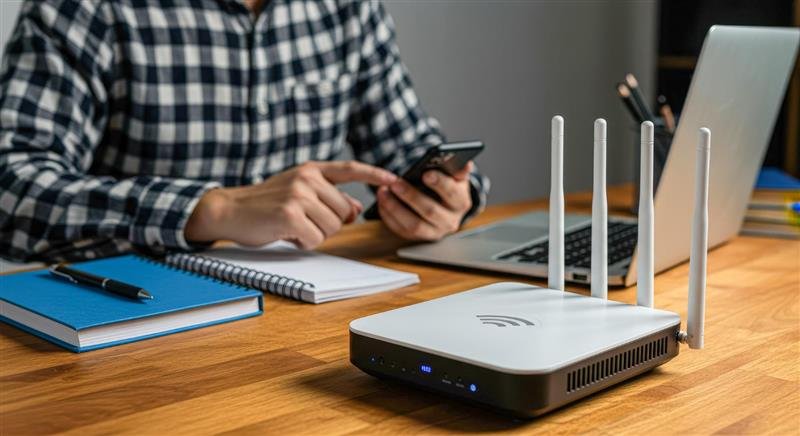Imagine this: your friend downloads a movie using the office Wi-Fi during lunch. Within minutes, the IT team pinpoints the exact device and sends a warning email. How did they catch it so fast? The answer is Nmap, a powerful open-source tool that scans, monitors, and secures computer networks.
Nmap (Network Mapper) is one of the most trusted tools in cybersecurity. IT administrators use it to see who’s connected; security analysts rely on it to find vulnerabilities before hackers do, and system administrators use it to keep networks running safely. But Nmap isn’t just for only professionals. With just a few basic Nmap commands, even beginners can explore their own networks, detect unknown devices, check which ports are open, and spot potential security risks in minutes.
Whether you’re a student learning ethical hacking or simply curious about what’s happening on your home Wi-Fi, learning Nmap commands is your first step toward understanding how network security truly works. In this blog, you’ll learn what Nmap does, how it works, the most useful commands, and how to interpret results safely and ethically.
How Nmap Works
If you’ve ever wondered how cybersecurity experts “see” what’s happening inside a network, that’s exactly where Nmap steps in. Every time you connect to Wi-Fi; whether at home, in a café, or in an office dozens of devices quietly talk to each other behind the scenes. To understand who’s connected, what services are running, and which connections might be risky, professionals use Nmap to perform what’s called a network scan.
So, before you start using it yourself, let’s look at what actually happens when you run one. When Nmap scans a network, it sends tiny data packets, like gentle taps on digital doors, to every device it can find. Each response Nmap receives is a clue: one device might reply “I’m here and open,” another might stay silent because its door is closed, and another might hide behind a firewall.
By collecting these clues within seconds, Nmap builds a clear, detailed map showing which systems are active, which “doors” (ports) are open, and what kind of operating systems or services are running.
In simple terms, Nmap is both the detective and the mapmaker of a network; it asks, listens, and then draws a picture of everything happening across your digital space. Understanding this process is the first step to using Nmap effectively and reading its results with confidence.
Essential Nmap Commands for Beginners
Now that you know how Nmap works and where to use it, let’s get to the fun part, actually running your first scans! Nmap might sound complex, but once you learn a few basic commands, you’ll realize it’s much simpler than it looks.
Think of these as your starter toolkit; the commands every beginner should know before diving deeper into ethical hacking or network analysis.
Here’s a quick and easy reference table to help you understand what each Nmap command list does:
Think of a simple home-network lab. Below is the device map for the Wi-Fi, we’ll scan two mobiles, a smart TV, your laptop, and one unknown device that showed up.
- 192.168.1.2 — Mobile A (your phone)
- 192.168.1.3 — Mobile B (partner’s phone)
- 192.168.1.4 — Smart TV
- 192.168.1.5 — Laptop (your laptop)
- 192.168.1.100 — Unknown device (appeared on the network)
Treat this as your practice playground: you’ll run safe Nmap scans against these IPs to discover who’s on the network, what services they expose (like web servers or SSH), and whether anything looks suspicious.
Always Remember: Only scan devices you own or have permission to test. Testing Nmap commands is about learning to see the invisible parts of a network, it’s not poking at other people’s systems. Unauthorized testing could lead to legal issues.
Below are realistic example commands you would run from your computer (Linux or Windows), a short sample of the kind of output Nmap might show, and a plain-language explanation of what that output means and what you might do next. Always run these only on your own network or on devices you’re allowed to test.
1. nmap -sn 192.168.1.0/24
Discover which devices are online
Command (find live hosts on your Wi-Fi):
nginx
nmap -sn 192.168.1.0/24
Ouput:
nginx
nginx
Nmap scan report for 192.168.1.2
Host is up (0.0012s latency).
Nmap scan report for 192.168.1.3
Host is up (0.0010s latency).
Nmap scan report for 192.168.1.4
Host is up (0.0030s latency).
Nmap scan report for 192.168.1.5
Host is up (0.0009s latency).
Nmap scan report for 192.168.1.100
Host is up (0.0045s latency).
Context: Nmap found five devices that answered. You now have IPs to investigate further, including the unknown 192.168.1.100.
2. nmap –top-ports 100 192.168.1.100
Quick focused port check on the unknown device
Command:
nginx
nmap –top-ports 100 192.168.1.100
output:
bash
PORT STATE SERVICE
22/tcp open ssh
80/tcp closed http
123/udp open ntp
Context: The unknown device answered on port 22 (SSH) and UDP 123 (NTP). That suggests it might be a Linux-based device or an IoT gadget.
Next step: identify the service versions.
3. nmap -sV -p 22,123 192.168.1.100
Service & version detection (what software is running)
Command:
nginx
nmap -sV -p 22,123 192.168.1.100
output:
pgsql
PORT STATE SERVICE VERSION
22/tcp open ssh OpenSSH 7.9p1
123/udp open ntp ntpd 4.2.8
Context: The device runs OpenSSH and an NTP service. If you don’t recognize the device, you might unplug it or block it from your router and investigate further in the router’s admin page.
4. sudo nmap -O 192.168.1.100
Operating system guess – use root/admin privileges
Command:
nginx
sudo nmap -O 192.168.1.100
output:
yaml
OS guesses: Linux 3.x – 4.x (moderate confidence)
Context: Nmap thinks the device runs Linux. This helps you decide what to check next (Linux-style services, open SSH, default passwords on IoT Linux devices, etc.).
5. sudo nmap -sS 192.168.1.100
Stealth (SYN) scan – fast port discovery
Command:
nginx
sudo nmap -sS 192.168.1.100
output:
bash
PORT STATE SERVICE
22/tcp open ssh
80/tcp closed http
139/tcp filtered netbios-ssn
Context: SYN scan quickly shows which doors are open. “Filtered” means a firewall is blocking the probe; you might not be able to tell if the port is open or closed without further checks.
6. nmap -sT 192.168.1.100
TCP (Transmission Control Protocol) connect scan – when you can’t do raw packets
Command:
nginx
nmap -sT 192.168.1.100
Context: Works without special privileges; results look like -sS but are recorded more easily on the target. Use if you don’t (or can’t) run as root/Administrator.
7. sudo nmap -sU 192.168.1.100 -p 123,161
UDP (User Datagram Protocol) scan – check services that use UDP
Command:
nginx
sudo nmap -sU 192.168.1.100 -p 123,161
output:
bash
PORT STATE SERVICE
123/udp open ntp
161/udp closed snmp
Context: Shows UDP (User Datagram Protocol) services; NTP (Network Time Protocol) is open; SNMP (Simple Network Management Protocol) is closed. UDP scans can take longer and sometimes need targeted ports.
8. nmap -p- 192.168.1.100
Scan all ports (full coverage)
Command:
nginx
nmap -p- 192.168.1.100
Context: Scans all 65,535 ports. This gives full coverage but may take much longer. Use it when you need to be thorough.
9. sudo nmap -A 192.168.1.100 -oN unknown_fullscan.txt
Aggressive scan (combine many checks)
Command:
nginx
sudo nmap -A 192.168.1.100 -oN unknown_fullscan.txt
Sample outputs inside file unknown_fullscan.txt include ports, versions, OS guess, and script output.
Context: -A is great for learning because it gives lots of detail in one run. It’s also obvious to logs and may trigger alerts; don’t run it on networks you don’t control.
10. nmap -T4 192.168.1.100
Timing control – speed vs stealth
Command (fast scan):
nginx
nmap -T4 192.168.1.100
Command (quieter scan):
nginx
nmap -T2 192.168.1.100
Context: -T4 is quicker but louder on the network; -T2 is slower and more cautious. Use slower timing on shared or monitored networks.
11. nmap -v -sV 192.168.1.100
Verbose output – watch what Nmap is doing
Command:
nginx
nmap -v -sV 192.168.1.100
Context: Adds progress messages so you can see which step Nmap is on (handy when scans take time).
12. nmap –script ssl-cert -p 443 192.168.1.5
Run a safe NSE script (certificate info on HTTPS)
Command:
css
nmap –script ssl-cert -p 443 192.168.1.5
output:
yaml
443/tcp open https
| ssl-cert: Subject: CN=example.local
| Issuer: CN=MyHomeCA
| Validity: …
Context: On your laptop at .5, Nmap shows SSL certificate details for an HTTPS service. Useful for inventorying devices and checking if certificates are default/self-signed.
13. nmap –script vuln 192.168.1.100
Run vulnerability scripts (only on authorized devices)
Command:
nginx
nmap –script vuln 192.168.1.100
Context: This runs a set of checks that try to detect common vulnerabilities. Only use on devices you own or have permission to test, because these checks can be intrusive.
14. nmap -sV -O -oA home_scan 192.168.1.0/24
Save results for later
Command:
nginx
nmap -sV -O -oA home_scan 192.168.1.0/24
Outcome: creates home_scan.nmap, home_scan.xml, and home_scan.gnmap files.
Context: Save the scan so you can review it, compare results after updates, or share with someone who helps you secure the network.
15. nmap –open 192.168.1.100
Focused output – show only open ports
Command:
nginx
nmap –open 192.168.1.100
Context: Filters the results to show only open ports—quickly highlights what’s active.
16. nmap –reason 192.168.1.100
Explain Nmap’s reasoning
Command:
nginx
nmap –reason 192.168.1.100
line:
arduino
22/tcp open ssh reason: syn-ack
Context: Tells you why Nmap classified the port as open/closed/filtered (useful while learning).
17. nmap –traceroute 192.168.1.100
Trace the path to the device
Command:
nginx
nmap –traceroute 192.168.1.100
Context: Shows the network hops between your computer and the target. In a simple home network, this will usually show just the router and the device.
18. nmap -6 <ipv6-address-of-device>
IPv6 scanning
Command:
nginx
nmap -6
Context: Use this form if your home network or device uses IPv6 addresses.
Example beginner workflow on your home Wi-Fi
- Discover devices: nmap -sn 192.168.1.0/24 → identify IPs.
- Quick common ports on unknown: nmap –top-ports 100 192.168.1.100 → get a shortlist.
- Inspect services: nmap -sV -p 22,80,443 192.168.1.100 → see versions.
- Save results: nmap -oN scan_results.txt 192.168.1.100 → keep file for review.
- Investigate unknown device (router UI, unplug or block if suspicious).
Final practical tips (simple)
- On Windows, run Command Prompt as Administrator or use Zenmap (the Nmap GUI) if you prefer a visual interface.
- On Linux/Kali, use sudo for scans that need raw packets (SYN, OS detection, etc.).
- Start small: -sn and –top-ports are great first steps.
- Keep a log of device IPs and names (router admin panel helps map IP → device name).
- If you find a truly unknown/suspicious device, change your Wi-Fi password, enable WPA2/WPA3, and block the device in the router until you investigate.
Important: Only scan networks you own or have permission to test. Unauthorized scanning can be illegal and unethical.
Remember, mastering these Nmap basics commands is like learning the alphabet of cybersecurity. Once you know them, the rest of your journey becomes a lot easier.
Think Like a Pro, Scan Like a Defender
Before diving into the technical depths of Nmap, it’s important to understand its true purpose. Nmap isn’t built for hacking; it’s built for protection. The same tool that unethical users exploit is the one cybersecurity professionals master to safeguard networks, detect threats early, and strengthen digital defenses.
Across the world, Nmap is part of every defender’s toolkit:
- IT administrators use it to spot devices overloading the network.
- Security analysts audit systems to uncover open ports and outdated services.
- Network defenders map out every device to identify weak points before attackers can.
Once you’ve mastered the fundamentals, you can advance to powerful Nmap commands and experiment with Nmap hacking commands in a legal, simulated environment sharpening the same skills ethical hackers use to defend organizations.
Learning Nmap isn’t just about typing commands; it’s about building the mindset of a defender. It’s the first step toward becoming the cybersecurity professional every organization needs. Aiming for a career in Cybersecurity? Check out our Cybersecurity Course designed to equip you with the technical mindset to look at security related challenges from a birds-eye view and understand how it fits within the larger scheme of things and not just make you a tools master who does only what’s instructed.
Nmap Command Classifications (Beginner-friendly)
1) Scan types (discover hosts & ports) — Find what’s there
| Command | What it Does | Example |
| -sS | SYN (stealth) scan — fast, common | nmap -sS 192.168.1.10 |
| -sT | TCP connect scan — completes handshake (use when raw packets unavailable) | nmap -sT 192.168.1.10 |
| -sU | UDP scan — checks UDP services (DNS, SNMP, etc.) | sudo nmap -sU 192.168.1.10 |
| -sn | Ping scan — list live hosts only (no port details) | nmap -sn 192.168.1.0/24 |
2) Port selection & targeting — Control what you scan
| Command | What it Does | Example |
| -p | Scan specific ports (comma separated) | nmap -p 22,80 192.168.1.10 |
| -p- | Scan all ports (1–65535) | nmap -p- 192.168.1.10 |
| –top-ports | Scan the top N most common ports quickly | nmap –top-ports 100 192.168.1.10 |
3) Detection & fingerprinting — Learn what’s running
| Command | What it Does | Example |
| -sV | Service & version detection (who’s behind the port) | nmap -sV 192.168.1.10 |
| -O | Operating system detection (best-effort OS guess) | sudo nmap -O 192.168.1.10 |
4) Timing & output control — Speed, stealth & feedback
| Command | What it Does | Example |
| -T0 … -T5 | Timing templates (T0 very slow/stealthy → T5 very fast) | nmap -T4 192.168.1.10 |
| -v / -vv | Increase verbosity — show progress and extra info | nmap -v 192.168.1.10 |
5) Nmap Scripting Engine (NSE) — Automate checks & extend Nmap
| Command | What it Does | Example |
| –script <name> | Run NSE scripts (e.g., ssl-cert, http-title) | nmap –script ssl-cert -p 443 192.168.1.10 |
| –script-help <script> | Show details about an NSE script | nmap –script-help ssl-cert |
| –script vuln | Run vulnerability-focused scripts (use only with permission) | nmap –script vuln 192.168.1.10 |
6) Output & reporting — Save and share results
| Command | What it Does | Example |
| -oN | Save normal (text) output | nmap -oN myscan.txt 192.168.1.10 |
| -oX | Save XML output | nmap -oX myscan.xml 192.168.1.10 |
| -oA | Save in all formats (text, XML, grepable) | nmap -A -oA myscan 192.168.1.10 |
7) Helpful flags & extras — Make results focused and explainable
| Command | What it Does | Example |
| –open | Show only open ports in output | nmap –open 192.168.1.10 |
| –reason | Show why Nmap chose a port state (learning aid) | nmap –reason 192.168.1.10 |
| –traceroute | Trace the network path to the host | nmap –traceroute 192.168.1.10 |
| -6 | Use IPv6 targets | nmap -6 <ipv6-address> |







